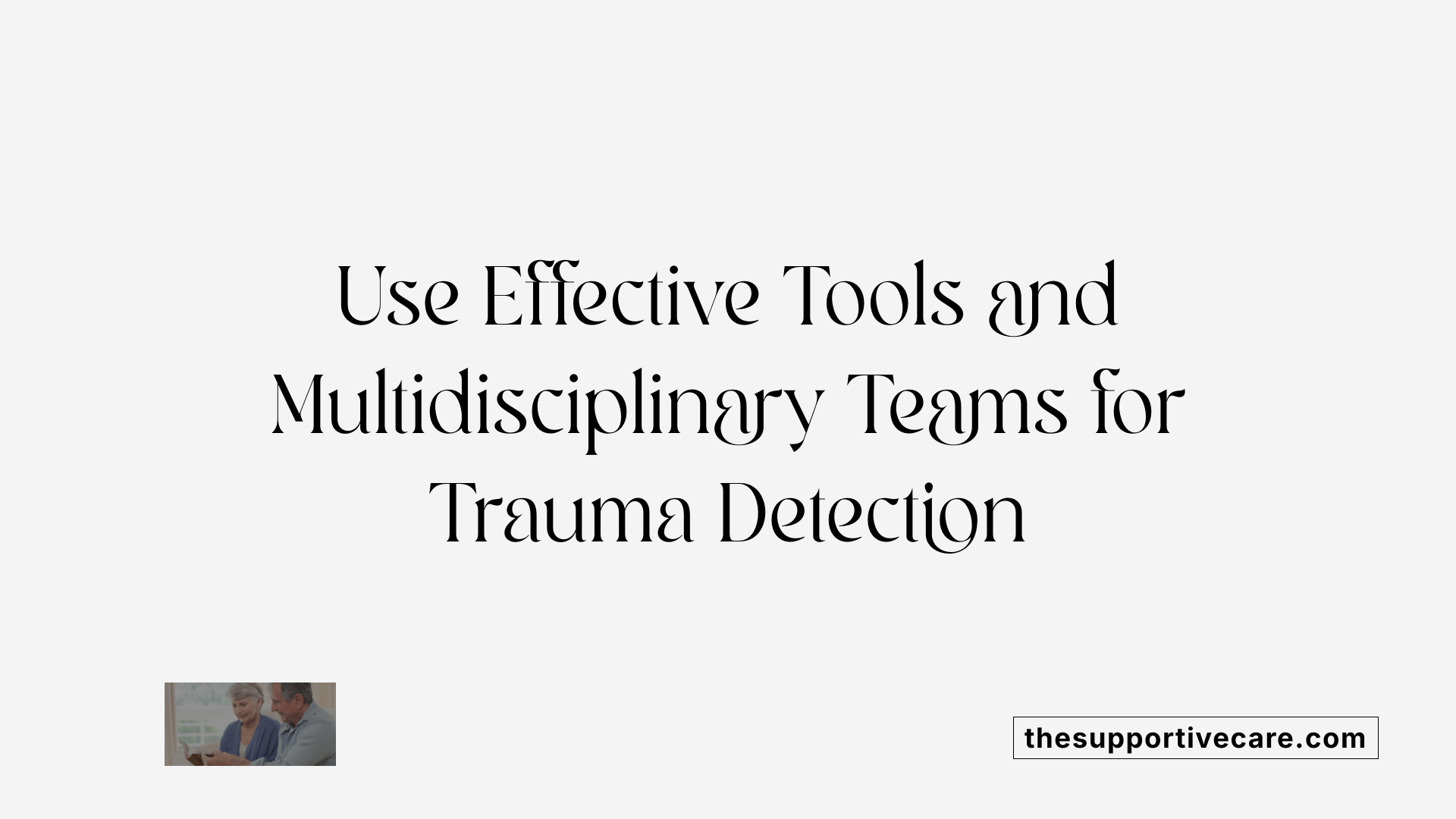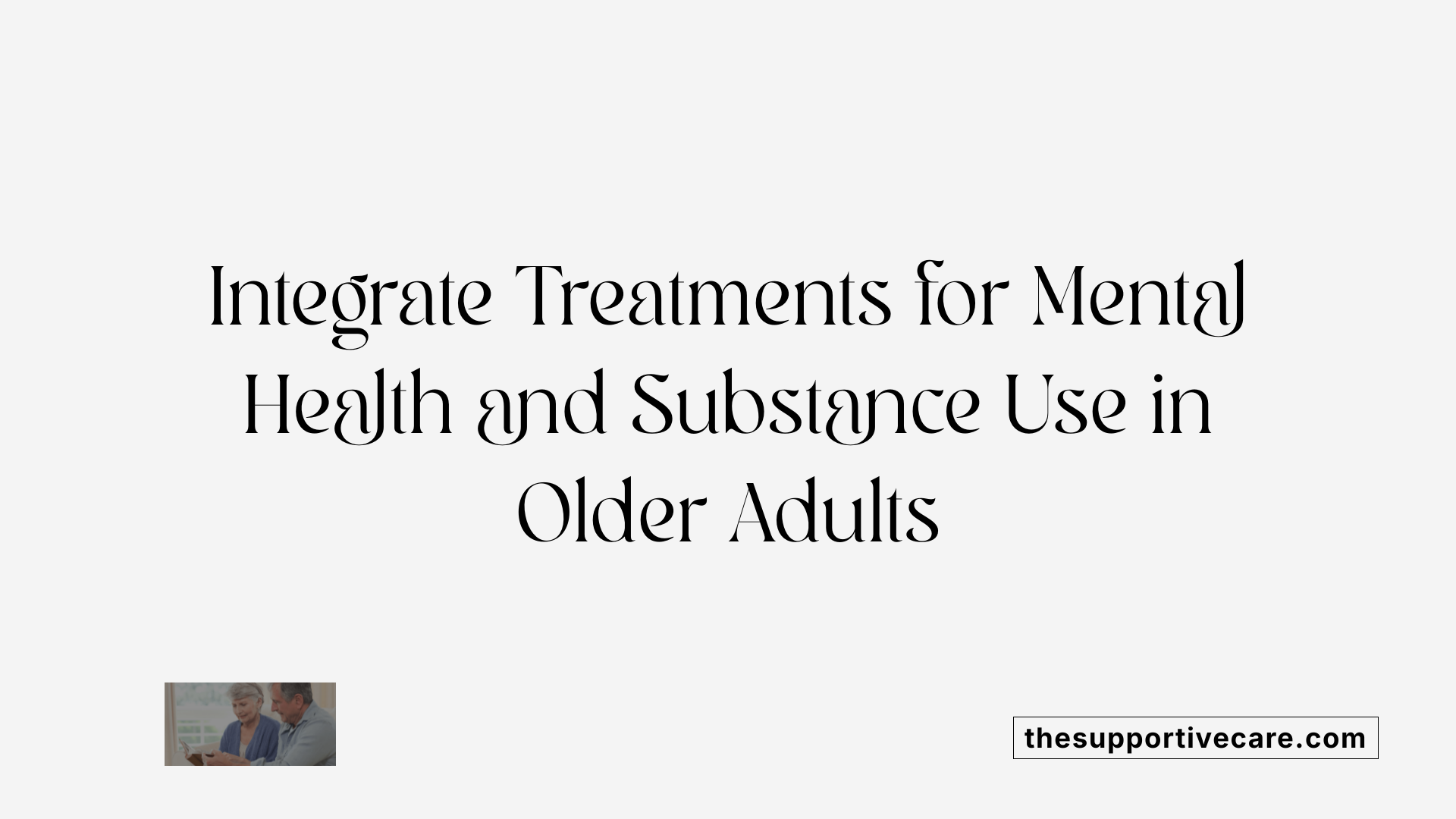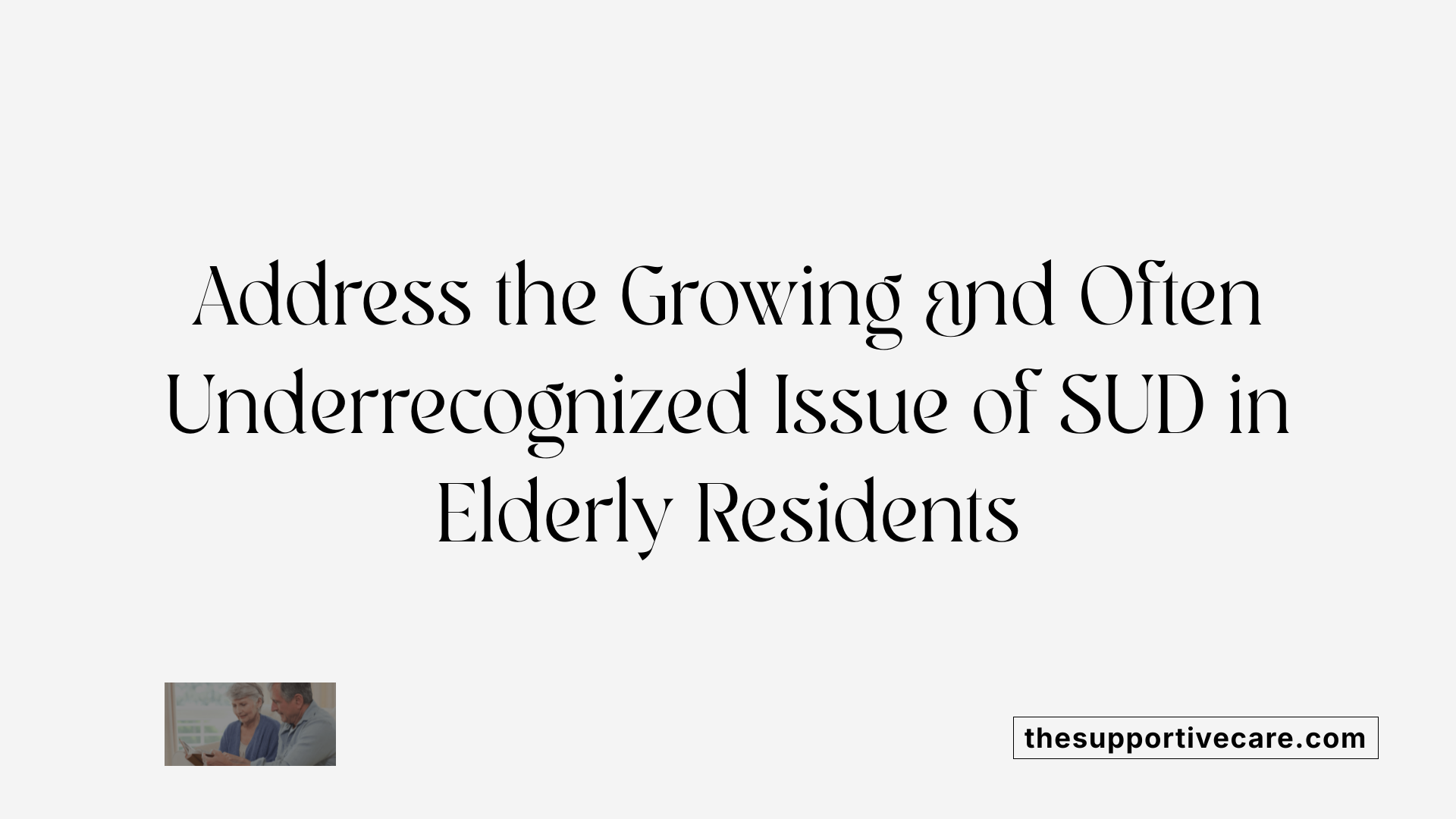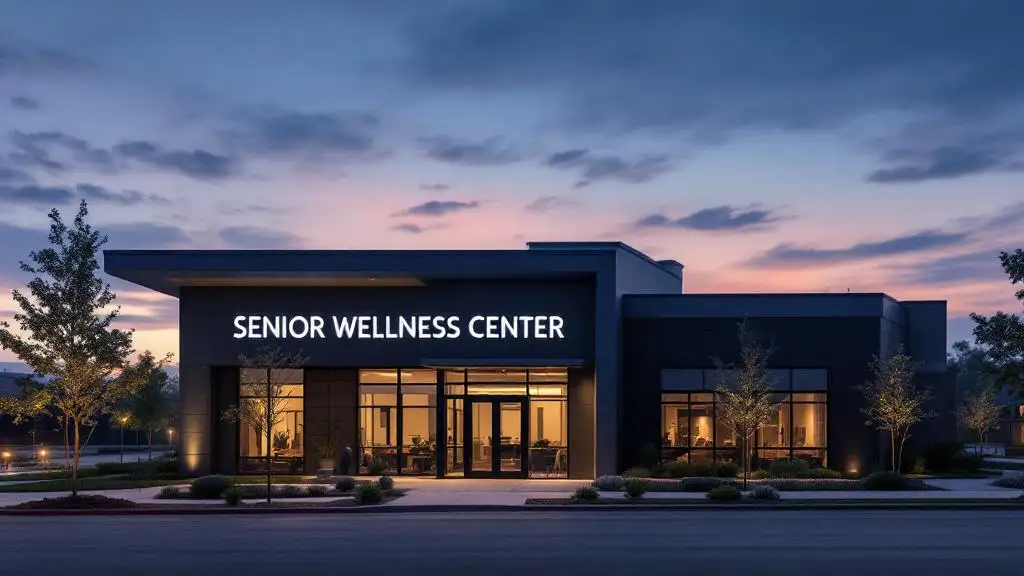The Hidden Struggles of Seniors with Trauma in Care Settings
Older adults residing in long-term care facilities often carry complex histories of trauma that influence their mental and physical health. Recognizing and addressing these challenges requires a deep understanding of trauma's lasting effects and the implementation of comprehensive, trauma-informed care approaches tailored to the unique needs of seniors. This article explores how long-term care facilities can better support seniors with trauma histories, integrating effective treatment strategies for substance abuse, mental health disorders, and trauma, while considering the broader social factors impacting this vulnerable population.
Understanding Trauma in Older Adults in Long-Term Care

What is Trauma and How Does It Affect Older Adults?
Trauma is defined as an experience that is physically or emotionally harmful and has lasting negative effects on a person's well-being. For older adults, trauma can deeply influence mental and physical health, impairing everyday functioning and increasing vulnerability to various medical issues.
What Are Common Sources of Trauma Experienced by Older Adults?
Older adults can face trauma from a variety of sources including war, natural disasters, interpersonal violence, and elder mistreatment. Significant life events like the death of loved ones or transitions into long-term care facilities—often perceived as a loss of home, independence, and control—also contribute. Historical traumas, such as those endured by Holocaust survivors, are particularly impactful for some elder populations.
How Common Is Trauma and PTSD Among Seniors?
Trauma is widespread with an estimated 70-90% of adults having experienced at least one traumatic event in their lifetime. Although the prevalence of full PTSD is lower in those over 65 compared to younger groups, many older adults suffer from subthreshold PTSD symptoms that still cause impairment and distress.
What Are the Signs and Symptoms of Trauma in Older Adults?
Symptoms in older adults may present uniquely and include intrusive thoughts, nightmares, mood swings, disorientation, memory loss, and visual flashbacks. Hypervigilance and somatic symptoms, such as unexplained aches or pains, are also common. Recognizing these signs is critical to providing appropriate trauma-sensitive care.
By understanding these elements, caregivers and long-term care facilities can better support older adults, ensuring trauma-informed approaches that honor their experiences and promote healing.
The Importance of Trauma-Informed Care in Long-Term Facilities

What is trauma-informed care?
Trauma-informed care (TIC) is an organizational framework designed to recognize and respond to the lasting effects of trauma. It prioritizes creating a safe environment and empowers individuals by fostering choice and control.
Core principles of trauma-informed care
TIC is built around several core principles: ensuring safety, respecting individuals' autonomy and choices, encouraging peer support, promoting transparency, sharing power, and maintaining cultural sensitivity. These elements work together to minimize retraumatization and support recovery.
Federal regulations mandating trauma-informed practices
Federal nursing home regulations now require facilities to implement trauma-informed and culturally competent care. This includes comprehensive care plans and behavioral health services tailored to address mental health, substance use, and trauma-related challenges. Staff members trained in these approaches provide person-centered, non-pharmacological interventions that respect the dignity of older adults.
Benefits of trauma-informed care for seniors
Implementing trauma-informed care in long-term facilities helps address trauma resulting from diverse events such as elder mistreatment, natural disasters, and historical traumas like the Holocaust. This approach improves mental and physical health outcomes by reducing intrusive symptoms, mood disturbances, and confusion. It also enhances trust between residents and caregivers, fostering better communication, adherence to medical plans, and overall well-being.
| Aspect | Description | Impact on Seniors |
|---|---|---|
| Safety and Empowerment | Ensuring safe spaces and fostering control | Reduces anxiety and fear, increases cooperation |
| Peer Support and Transparency | Encouraging sharing and openness | Builds solidarity and decreases isolation |
| Cultural Sensitivity | Respecting diverse backgrounds and experiences | Improves respect and individualizes care |
| Regulatory Compliance | Federal mandates for trauma-informed care | Guarantees adherence to care standards and quality |
Recognizing and Assessing Trauma in Elderly Residents

What screening tools are effective for identifying trauma in older adults?
Screening for trauma and PTSD in elderly residents is crucial, yet it demands instruments that consider age-related challenges. Recommended tools include the Life Events Checklist (LEC) and the PTSD Checklist for DSM-5 (PCL-5). These tools effectively identify trauma histories and PTSD symptoms in seniors and have demonstrated reliability across age groups. However, clinicians often need to adapt these tools to suit older adults' specific conditions.
Challenges in diagnosing trauma in seniors
Diagnosing trauma in elderly populations can be complicated by several factors. Symptoms of trauma may resemble or overlap with other age-related medical or cognitive conditions, such as dementia or mood disorders. Additionally, trauma symptoms might present more subtly or atypically, often showing as hypervigilance or somatic complaints rather than classic PTSD signs. Importantly, some seniors may not volunteer trauma experiences due to stigma or memory issues.
Adapting assessments for sensory and mobility issues
Sensory impairments such as hearing loss or vision decline and mobility limitations are common in older adults and can hinder effective trauma assessment. To address these barriers, assessments should be adapted—using larger print materials, ensuring clear auditory communication, and allowing for comfortable physical positioning during interviews. Assessors must also be sensitive to fatigue or pain that may affect concentration and participation in screening.
Role of multidisciplinary teams
Effective trauma assessment and care for elderly residents benefit greatly from multidisciplinary team involvement. Teams often include mental health professionals, medical providers, social workers, and trained caregivers who collaborate to perform comprehensive evaluations. This approach ensures that physical health conditions, cognitive status, emotional wellbeing, and social determinants of health all inform assessment and subsequent care planning. Multidisciplinary teams facilitate tailored interventions, improving trauma recognition and supporting recovery in older adults.
Addressing Co-Occurring Mental Health Disorders in Seniors with Trauma

How prevalent are co-occurring mental health conditions and trauma in older adults?
Seniors often face a complex interplay of mental health disorders and trauma histories. Many older adults endure trauma from events such as war, interpersonal violence, loss of loved ones, and health crises. These experiences can lead to mental health conditions like depression, PTSD, anxiety, and substance use disorders. Co-occurring disorders are common and complicate diagnosis and treatment, especially as symptoms may be masked by overlapping physical illnesses or aging-related changes.
How do treatment programs address co-occurring mental health issues alongside addiction?
Treatment programs for older adults emphasize integrated, patient-centered care that simultaneously treats substance use disorders and mental health conditions. These programs utilize thorough assessments to identify co-occurring issues and then tailor interventions accordingly. Behavioral therapies such as cognitive-behavioral therapy (CBT) and motivational interviewing (MI) are combined with medication management and psychosocial support to address both dimensions.
What psychotherapeutic and pharmacological interventions are effective?
Psychotherapy approaches like CBT, trauma-focused therapies (including EMDR and prolonged exposure), and motivational interviewing work effectively for older adults, often adapted to accommodate sensory and mobility challenges. Medications such as antidepressants (SSRIs and SNRIs) and treatments for substance use disorders (e.g., naltrexone, buprenorphine) are used cautiously, considering age-related pharmacodynamics and potential side effects. Collaborative care models help integrate these treatments within a multidisciplinary team.
How is collaborative and patient-centered care implemented?
Collaborative care involves coordinating among healthcare providers, behavioral health specialists, and community supports to ensure comprehensive management. The focus is on trauma-informed, culturally sensitive care that promotes empowerment, safety, and choice for older adults. Family involvement and social support are encouraged to enhance adherence and address social determinants like isolation and stigma. Telepsychiatry and community health workers also expand access and engagement.
These integrated strategies have been shown to improve mental health and substance use outcomes in older adults with trauma histories, recognizing the need for personalized approaches that honor their unique experiences and resilience.
Substance Use Disorders Among Seniors in Long-Term Care

Prevalence and Under-Recognition of Substance Use Disorders in Older Adults
Substance use disorders (SUD) among older adults, particularly those residing in long-term care settings, are increasing but frequently go undetected. Despite a growing population of seniors with SUD, older adults often remain under-screened and underdiagnosed. For example, more than 90% of skilled nursing facility residents diagnosed with opioid use disorder do not receive medications for opioid use disorder (MOUD), underscoring a significant treatment gap.
Risk Factors and Consequences
Risk factors for SUD in seniors include physiological changes such as decreased liver function, which affects drug and alcohol metabolism, increasing risks for adverse events like falls, cognitive decline, and medication interactions. The consequences of untreated SUD are severe, with older adults showing higher rates of comorbidities, geriatric syndromes, and increased mortality. Opioid overdose deaths among older adults have tripled in recent decades.
Common Substances Misused
Alcohol remains the most commonly misused substance among adults over 60, followed by cannabis. Cannabis use among seniors has surged by 75% between 2015 and 2018, often driven by attempts to manage chronic pain, arthritis, anxiety, depression, and sleep disturbances. Prescription and illicit drug misuse also contribute substantially to the SUD burden in this demographic.
Challenges in Detection and Diagnosis
Detection is complicated by symptom overlap between substance misuse and age-related medical or cognitive conditions. Routine and careful screening with appropriate tools is essential but not consistently implemented. Symptoms of misuse may be masked or misinterpreted, contributing to under-recognition.
What Types of Addiction Can Be Treated Through Comprehensive Programs?
Comprehensive treatment programs address addictions to alcohol, prescription medications, illicit drugs, and behavioral addictions such as gambling. They feature tailored care levels including medical and psychosocial interventions, evidence-based therapies, and medication management. Importantly, these programs also focus on co-occurring mental health conditions, providing holistic care suited to each individual's needs.
These programs are vital for improving outcomes for seniors with SUD in long-term care, helping bridge current treatment gaps and addressing the complexities unique to this age group.
Comprehensive Treatment Services for Seniors with Addiction and Trauma
What Are the Comprehensive Treatment Services Available for Substance Abuse and Addiction?
Treatment programs for older adults facing substance abuse and trauma encompass several integrated components designed to address their unique needs. Core services include medically managed detoxification and crisis stabilization, which provide a safe and supportive environment for initial recovery phases.
Behavioral therapies like cognitive-behavioral therapy (CBT) and motivational interviewing (MI) are adapted to suit older populations. Medication-assisted treatment (MAT), including medications such as naltrexone, plays a critical role and is carefully prescribed to account for age-related pharmacologic sensitivities.
Age-appropriate and trauma-informed approaches are crucial, considering many seniors have histories of trauma including war, interpersonal violence, or historical events like the Holocaust. Trauma-informed care focuses on empowerment, safety, and minimizing retraumatization and integrates peer support with mental health stabilization.
Aftercare planning is another essential component, addressing community reintegration and ongoing support to sustain recovery. This involves coordination of services like sober housing, ongoing counseling, and addressing social determinants such as isolation and stigma.
Such comprehensive programs recognize addiction as a chronic condition, emphasizing personalized care models and collaborative team efforts to optimize outcomes for seniors.
| Component | Description | Special Considerations for Older Adults |
|---|---|---|
| Detoxification and Crisis Stabilization | Medically managed withdrawal with safety monitoring | Account for comorbidities and medication interactions |
| Behavioral Therapies | CBT, MI, trauma-focused therapies | Tailored to cognitive and sensory needs, addressing trauma sequelae |
| Medication-Assisted Treatment (MAT) | Use of medications like naltrexone, buprenorphine | Cautious prescribing due to side effects and polypharmacy risk |
| Trauma-Informed Care | Emphasizes safety, respect, peer support, empowerment | Integrates mental health stabilization and avoids retraumatization |
| Aftercare and Community Reintegration | Ongoing support, sober housing, relapse prevention | Addresses isolation, fosters social engagement, and ensures continuity of care |
These comprehensive treatments, supported by federal funding and evidence-based practices, are essential for effective recovery and improved quality of life among older adults with substance use disorders and trauma histories.
Integrating Trauma-Focused Psychotherapy into Senior Care
What psychotherapy options are effective for trauma in older adults?
Older adults benefit from several evidence-based trauma-focused psychotherapies, including cognitive-behavioral therapy (CBT), cognitive processing therapy (CPT), prolonged exposure therapy, and eye movement desensitization and reprocessing (EMDR). These therapies effectively address post-traumatic stress symptoms and other trauma sequelae. Importantly, dropout rates among seniors undergoing these treatments are low, reflecting good acceptability and tolerability in this age group.
How are therapies adapted for sensory and cognitive challenges?
Providing psychotherapy to older adults often requires adaptations to accommodate sensory impairments such as vision or hearing loss, and cognitive issues including memory deficits or slower information processing. Therapists may use larger print materials, speak clearly and at a measured pace, incorporate more frequent breaks, and repeat key points. Sessions can also be tailored to consider comorbid physical health problems and mobility limitations to optimize participation.
Are trauma-focused therapies safe for seniors?
There are no identified contraindications for trauma-focused therapies specific to older adults. Contrary to some concerns, exposure therapy has not been found to worsen physical health outcomes in the elderly. Untreated post-traumatic symptoms, however, may contribute to negative health effects such as accelerated aging and increased mortality, underscoring the importance of treatment.
Can psychotherapy be combined with pharmacological treatments?
Yes, trauma-focused psychotherapy can be effectively combined with medication management. Selective serotonin reuptake inhibitors (SSRIs) and serotonin-norepinephrine reuptake inhibitors (SNRIs) are commonly prescribed to manage trauma-related symptoms. However, prescribing must be cautious given increased vulnerability to side effects and potential drug interactions in older adults. Personalized and closely monitored treatment plans ensure safety and improved outcomes.
| Therapy Type | Adaptations for Seniors | Safety Profile | Use with Medications |
|---|---|---|---|
| Cognitive-Behavioral Therapy | Slower pace, sensory aids, breaks | Low dropout, no contraindications | Effective with cautious SSRI use |
| Cognitive Processing Therapy | Tailored for memory and cognitive decline | Safe and well tolerated | Combined with pharmacotherapy |
| Prolonged Exposure Therapy | Adjustments for physical health and mobility | No worsening of physical health documented | Supports medication treatment |
| Eye Movement Desensitization and Reprocessing (EMDR) | Adapted communication and sensory accommodations | Low dropout, accepted by seniors | Used alongside SSRIs/SNRIs |
Managing PTSD and Trauma Symptoms in Elderly Residents
How do PTSD symptoms differ or emerge in older adults?
PTSD symptoms in older adults often present uniquely compared to younger populations. Although the lifetime prevalence of full PTSD is lower in those aged 65 and over (about 3%), many experience subthreshold symptoms that still cause significant impairment. Symptoms may appear or worsen later in life, triggered by life transitions such as retirement, losing loved ones, or facing physical health declines.
Unique PTSD presentations in older adults
Older adults might exhibit increased hypervigilance and somatic complaints rather than classic PTSD symptoms seen in younger people. They may also experience more chronic or long-standing symptoms, sometimes masked by other medical or cognitive conditions. It's essential to screen carefully for PTSD even if symptoms aren't openly acknowledged.
Medication considerations and side effect risks
Pharmacological treatments for PTSD can be effective in older adults, including SSRIs, SNRIs, and other medications. However, older patients are more susceptible to side effects and potential drug interactions due to physiological changes with aging. Careful prescribing, low starting doses, and close monitoring are necessary to minimize risks.
Avoiding retraumatization during medical care
Medical treatments and procedures can inadvertently reactivate traumatic memories in elderly trauma survivors. Healthcare providers should adopt trauma-informed approaches focused on safety, clear communication, and patient empowerment to prevent retraumatization. Understanding each patient's unique trauma history helps tailor care appropriately, improving both mental and physical health outcomes.
The Impact of Trauma on Physical Health and Aging
What are the health consequences of untreated trauma in older adults?
Untreated trauma in older adults has profound impacts on their physical health and aging process. It is closely linked to accelerated aging and contributes to increased risks of chronic conditions such as heart disease, arthritis, and osteoporosis. These health issues often coincide with disabilities, making daily functioning more difficult and reducing overall quality of life.
Trauma also plays a significant role in chronic pain and cognitive decline. Older adults with unresolved trauma may experience heightened autonomic arousal and altered neurological functioning, which can worsen symptoms of neurodegenerative disorders. Cognitive impairments linked to trauma can further complicate management of aging-related diseases.
Moreover, trauma can negatively influence health behaviors. Individuals suffering from the sequelae of traumatic events may struggle with maintaining healthy lifestyles, which exacerbates risks of obesity, smoking, and other conditions that accelerate physical decline. This cycle of adverse health behaviors and outcomes contributes to increased mortality among this population.
Why is early intervention important?
Early detection and intervention are crucial to mitigate the harmful effects of trauma on aging adults. Trauma-informed care that recognizes and responds to trauma’s long-lasting effects supports better health outcomes by promoting safety, empowerment, and control. Effective psychotherapeutic treatments, such as cognitive-behavioral therapy and trauma-focused interventions, alongside cautious medication management, can reduce symptoms and improve resilience.
Intervention strategies also target improved health behaviors and pain management, which help decelerate the aging decline linked to trauma. Comprehensive care models that integrate mental health, physical health, and social support foster better management of trauma sequelae and enhance quality of life.
Addressing trauma timely not only prevents worsening of physical health but can also reduce mortality rates and improve overall well-being in older adults.
The Role of Social Determinants in Supporting Trauma-Impacted Seniors
How do social factors affect mental health in older adults?
Social determinants such as social isolation, loneliness, and ageism profoundly impact the mental health of older adults, especially those affected by trauma. Isolation and loneliness are linked to health risks that are as severe as smoking and obesity, contributing to poorer overall well-being. Ageism adds another layer of difficulty, influencing access to care and the quality of support received.
Moreover, workforce shortages in elder care reduce the availability of dedicated professionals to address the complex mental health needs of seniors. This shortage limits opportunities for meaningful social interaction and appropriate mental health interventions.
Importance of social support and engagement
Strong social support and regular engagement are crucial in counteracting the negative effects of trauma and isolation in older adults. Positive psychiatry highlights the role of resilience, optimism, and active social participation in promoting better mental health outcomes. Seniors who cultivate these positive traits tend to experience enhanced happiness, reduced depression, lower levels of loneliness, and increased protection against stigma.
Promoting activities that nurture social connections and personal mastery can help older adults build their psychological resilience. Social engagement is not just a preventive measure but also a vital part of recovery and ongoing mental well-being.
Positive psychiatry principles promoting resilience and well-being
Positive psychiatry focuses on enhancing well-being and resilience by encouraging optimism, social involvement, and a sense of control over life circumstances. This approach recognizes the valuable contributions of aging individuals, including their accumulated wisdom and prosocial behaviors.
By incorporating these principles into care strategies, providers can foster environments where trauma-impacted seniors feel empowered and supported. This holistic focus aids in mitigating the effects of trauma and improving the overall quality of life for older adults.
Through addressing social determinants—such as mitigating isolation, combating ageism, and enhancing workforce capacity—combined with the promotion of resilience and social engagement, we can better support the mental health of seniors who have experienced trauma.
Implementing Person-Centered, Trauma-Informed Models in Care Facilities
ACL's Development of Trauma-Informed Care Models
The Administration for Community Living (ACL) has pioneered and expanded person-centered, trauma-informed (PCTI) care models tailored to older adults. These models focus on recognizing trauma's lasting impacts with the goal of shaping healthcare environments that honor individuals' histories and promote healing.
Promoting Dignity, Strengths, and Empowerment
Central to these care approaches is prioritizing respect and empowerment. By emphasizing a person's dignity and strengths, care providers create a supportive atmosphere that fosters resilience and control over their own health journey, crucial for trauma survivors. This framework helps mitigate retraumatization and builds trust between patients and caregivers.
Addressing Diverse Trauma Histories
Acknowledging that trauma among older adults arises from various sources—including Holocaust survivors, veterans, refugees, and victims of war or violence—ACL's efforts encompass comprehensive strategies tailored to distinct population needs. For example, Holocaust survivors, a population disproportionately at risk for physical and emotional health challenges, benefit specifically from culturally sensitive care acknowledging their historical trauma.
Comprehensive Care Management and Caregiver Support
Trauma-informed models also include broad care management processes that integrate psychosocial interventions, support for caregivers, dementia-specific care, and end-of-life planning. This holistic approach ensures that the complexity of trauma’s effects is managed across physical, emotional, and social domains, promoting optimal well-being in elder care settings.
Overcoming Barriers to Mental Health and SUD Treatment in Long-Term Care
What are the challenges faced by long-term care facilities in addressing mental health and SUD?
Long-term care and skilled nursing facilities often face significant challenges in providing adequate treatment for residents with mental health disorders and substance use disorders (SUD). Many facilities are underprepared due to limited resources and high staff turnover rates, which hinder consistent and effective care delivery. Additionally, many staff members lack specialized training to manage the complex needs of older adults with these conditions.
How do financial and regulatory factors impact care?
Financial challenges greatly affect the quality of care in nursing facilities. A critical issue is the reimbursement imbalance, with Medicare typically providing better coverage than Medicaid, the primary payer for many older adults in long-term care. This financial strain limits facilities' ability to invest in specialized programs and staff training. Regulatory uncertainties and restrictions around medications for opioid use disorder (MOUD), such as buprenorphine and methadone, complicate access despite recent policy flexibilities aimed at expanding treatment options.
What role does stigma play?
Stigma toward mental illness and substance use disorders persists in long-term care settings. It can discourage residents from seeking help and contribute to insufficient prioritization of these conditions by caregivers and administrators. This stigma exacerbates barriers to treatment, leading to underdiagnosis and inadequate care for affected individuals.
What strategies can improve access and treatment quality?
Efforts to improve care include comprehensive staff training programs focused on SUD and mental health, increasing awareness and competency in evidence-based practices such as motivational interviewing and cognitive-behavioral therapy tailored for older adults. Policy initiatives advocate for enhanced reimbursement models, expanded accessibility of MOUD within nursing facilities, and the establishment of quality metrics specific to SUD treatment. Collaborative care models integrating community health workers and telepsychiatry have shown promise in increasing engagement and treatment effectiveness in this population.
Table: Barriers and Strategies to Enhance Mental Health and SUD Care in Long-Term Care Settings
| Barrier Category | Specific Challenges | Improvement Strategies |
|---|---|---|
| Facility Preparedness | Underresourced, high staff turnover | Staff training, technical assistance |
| Financial/Regulatory | Reimbursement imbalance, MOUD prescribing limits | Policy reforms, reimbursement improvements |
| Stigma | Negative attitudes among staff and residents | Education, awareness campaigns |
| Treatment Access | Limited screening and treatment availability | Integrated care models, telepsychiatry |
Innovations and Policy Reforms to Enhance Care for Seniors with SUD and Trauma
Staff Training Programs and Technical Assistance
Facilities caring for older adults with substance use disorders (SUD) face challenges such as underresourcing and staff shortages. Recent innovations include comprehensive staff training programs designed to equip healthcare workers with skills in trauma-informed care and evidence-based SUD treatment. Technical assistance resources support implementation of best practices, ensuring quality care tailored to the unique needs of seniors.
Collaborative and Integrated Care Models
Integrated healthcare approaches combine medical, behavioral, and social services to better address the complex health profiles of older adults with SUD and trauma histories. These models often incorporate community health workers, lay counselors, and telepsychiatry, improving access, engagement, and continuity of care while emphasizing patient-centered and trauma-informed frameworks.
State-Sponsored Initiatives and Reimbursement Improvements
State-level efforts play a crucial role in expanding treatment access by providing policy toolkits, funding, and technical support to nursing facilities. Policy reforms target reimbursement imbalances, especially those favoring Medicare over Medicaid, enhancing financial sustainability for SUD programs. Establishing SUD-specific quality metrics also encourages higher standards of care.
Expanding Access to Medications for Opioid Use Disorder (MOUD)
Despite evidence showing MOUD can halve mortality in opioid use disorder among older adults, over 90% of skilled nursing facility residents with this diagnosis do not receive these medications. Recent regulatory flexibilities have broadened prescribing abilities for drugs like buprenorphine and methadone. However, adoption remains limited, prompting calls for legal reforms to ease prescribing restrictions and improve medication accessibility.
| Innovation Area | Description | Key Benefits |
|---|---|---|
| Staff Training & Technical Support | Educating facility staff in trauma-informed, age-sensitive SUD care with ongoing technical assistance | Enhances skill set; improves care quality |
| Collaborative Integrated Care | Combining medical, behavioral, and social services with telepsychiatry and community health worker involvement | Improves access and patient engagement |
| State-Sponsored Initiatives | Policy toolkits, funding support, reimbursement reform, and quality metric development | Financial sustainability; standardized care |
| Expanded MOUD Access | Regulatory flexibility for prescribing buprenorphine and methadone, alongside legal reforms | Reduces opioid mortality; increases treatment adherence |
Preventive Strategies to Support Mental Health and Cognition in Seniors
Education and Lifestyle Engagement
Lifelong learning and active engagement in social and cognitive activities are crucial for seniors in maintaining mental acuity and overall well-being. Educational programs that encourage older adults to participate regularly in mentally stimulating tasks help preserve cognitive function and provide social interaction opportunities, which reduce feelings of isolation and loneliness.
Physical Activity and Vascular Risk Control
Regular physical exercise is an essential part of preventive care for older adults. It not only enhances cardiovascular health but also supports brain function by improving blood flow and reducing vascular risks such as hypertension and diabetes. Controlling these vascular factors can significantly delay the onset of cognitive decline and related disorders.
Delaying Cognitive Decline and Dementia
Engagement in physical, social, and cognitive activities, combined with managing health risks, has shown effectiveness in delaying or preventing the progression of dementia. Prevention strategies also include controlling vascular risks and encouraging continuous mental challenges to strengthen brain resilience.
Positive Psychiatry in Promoting Well-Being and Resilience
The concept of positive psychiatry emphasizes fostering strengths like resilience, optimism, and social involvement. These attributes are associated with better health outcomes, greater happiness, reduced depression, and lower loneliness among older adults. Promoting personal mastery and social engagement supports healthy aging and protects mental health against age-related challenges.
These preventive strategies collectively empower seniors to maintain their mental health and cognitive functions, enhancing quality of life as they age.
Building Trust and Communication to Enhance Treatment Outcomes
The Role of Clear Communication and Continuity of Care
Effective communication forms the cornerstone of building trust between healthcare providers and older adults affected by trauma. Clear, consistent explanations about diagnosis, treatment options, and care plans help patients feel respected and empowered. Continuity of care—seeing familiar providers over time—strengthens this trust, creating a safe environment where patients are more willing to share sensitive information.
Trauma-Sensitive Approaches Preventing Retraumatization
Healthcare systems adopting trauma-informed care emphasize safety, transparency, and cultural sensitivity to prevent retraumatization. By understanding trauma’s lasting impact, providers tailor interactions to avoid triggering stress or fear responses. This approach fosters a sense of control and dignity for older adults, reducing anxiety and improving engagement in treatment.
Encouraging Screening and Openness Among Patients
Routine trauma screening, using tools like the PTSD Checklist for DSM-5, is encouraged by staff trained in trauma sensitivity. When patients sense that providers are empathetic and trustworthy, they are more likely to disclose trauma histories, which is essential for personalized care planning. Respecting patient choice while gently facilitating openness facilitates important dialogues without pressure.
Impact on Medical Adherence and Reduced Distress
Trust cultivated through communication and trauma-sensitive practices leads to improved medical adherence, as patients feel more comfortable following recommendations. Enhanced trust and reduced distress result in better psychological and physical health outcomes. Addressing trauma openly helps mitigate risks like accelerated aging, chronic illness progression, and depression, ultimately supporting healthier aging trajectories.
Towards Holistic and Compassionate Care for Trauma-Affected Seniors
Supporting seniors with histories of trauma in long-term care facilities demands a multifaceted approach that integrates trauma-informed practices, comprehensive treatment for substance use and mental health disorders, and attention to social determinants of health. By adopting person-centered models that emphasize safety, empowerment, and dignity, facilities can address the unique challenges faced by this vulnerable population and improve their quality of life. Innovations in policy, workforce training, and collaborative care further strengthen these efforts. Ultimately, recognizing the resilience and strengths of older adults alongside their care needs paves the way for healthier, more supportive environments that honor their lived experiences and promote sustained recovery and well-being.
References
- Home | SAMHSA - Substance Abuse and Mental Health ...
- Mental health care for older adults: recent advances and new ...
- Older Adults and PTSD - PTSD: National Center for PTSD
- Person-Centered, Trauma-Informed Service
- Trauma-Informed Care: Nursing Facility Requirements and ...
- Caring for Traumatized Elders: Lessons Learned From ...
- Improving Access To Substance Use Disorder Care In ...
- Treating substance misuse in older adults
- Treatment Types for Mental Health, Drugs and Alcohol



































































































